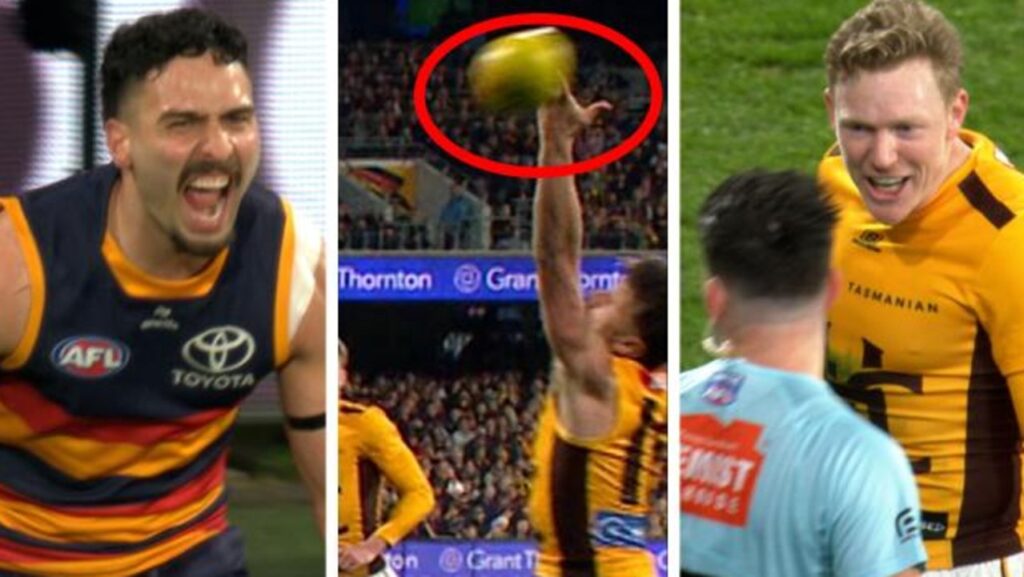
The spotlight has once again turned to the umpires in the Australian Football League (AFL) following two contentious 50-metre penalties during the fourth quarter of Friday night’s thrilling match between Adelaide and Hawthorn. The penalties, which significantly influenced the game’s outcome, have sparked discussions about the consistency of officiating and the rules governing player dissent.
In a pivotal moment at the nine-minute mark of the final term, Adelaide’s Izak Rankine was awarded a mark for what replays later showed to be a touched kick by Alex Neal-Bullen. Despite the apparent error, the officiating umpire penalized Rankine with a 50-metre penalty after he moved off his mark multiple times, seemingly unsure if the mark had been paid. This decision allowed Rankine to extend Adelaide’s lead from six to twelve points, a critical advantage as the game intensified.
Post-match, Rankine admitted to Fox Footy that he was aware the ball had been touched but claimed he couldn’t hear the umpire’s whistle due to the crowd’s noise.
“It was touched … it was too loud; I couldn’t hear the whistle,”
Rankine explained, denying any intention to draw a penalty.
Contentious Decisions and Player Reactions
Former Collingwood coach Nathan Buckley questioned Rankine’s actions, asking if he was attempting to draw a 50-metre penalty. Rankine refuted the suggestion, maintaining that his actions were unintentional. Meanwhile, Herald Sun journalist Jon Ralph provided further analysis on Fox Footy, highlighting the umpire’s communication with Hawthorn’s James Sicily during the incident. Ralph noted that the umpire had clearly stated he had not called play on, yet the ball was evidently touched, and Rankine had attempted to play on.
The controversy didn’t end there. Shortly after, Hawthorn’s Jack Gunston capitalized on a similar situation when he was awarded a free kick in the goalsquare following a sequence involving teammate Mitch Lewis. Lewis appeared to take advantage of a free kick, but after his attempt to score failed, the umpire called play back to the original infringement, leading to further confusion.
The Impact of Dissent and Rule Enforcement
The incident involving Gunston was compounded when Mark Keane protested the umpire’s decision by pointing to the scoreboard, resulting in another 50-metre penalty. This decision mirrored a similar situation two weeks prior, when Fremantle’s Karl Worner was penalized for the same action. Nathan Buckley expressed his frustration with the enforcement of the dissent rule, arguing that penalizing players for highlighting questionable decisions only exacerbates the issue.
“Whilst we’re at it, we need to have a look at the dissent rule. If Mark Keane points to it (the scoreboard) saying that actually was a bad decision, but then (by penalizing him with a 50-metre penalty) you’re making a bad decision even worse,”
Buckley stated on Fox Footy. He emphasized the need for clarity and consistency in officiating to prevent similar situations in the future.
Historical Context and Future Implications
The debate over umpiring decisions and the dissent rule is not new to the AFL. Over the years, the league has faced criticism for inconsistent officiating, prompting calls for reforms and better training for umpires. The introduction of additional umpires and technological aids has been suggested as potential solutions to improve decision-making accuracy.
As the AFL continues to evolve, the league’s governing body may need to revisit the rules surrounding player dissent and the communication between umpires and players. Ensuring that players understand the rationale behind decisions and maintaining transparent communication could help mitigate disputes and enhance the overall integrity of the game.
Looking ahead, the AFL will need to address these issues to maintain the trust of players, coaches, and fans alike. As the season progresses, the league’s response to these controversies will be closely watched, with potential implications for future rule changes and officiating protocols.






